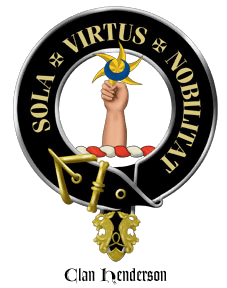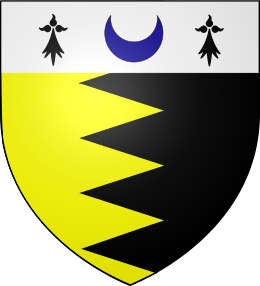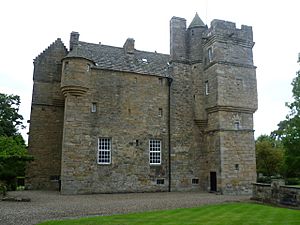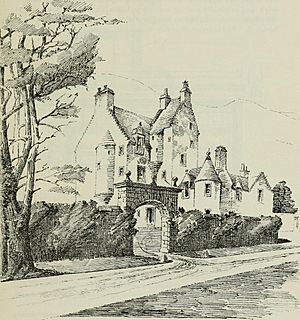Clan Henderson facts for kids
Quick facts for kids Clan Henderson/MacEanruig |
|||
|---|---|---|---|
| Mac Eanruig | |||
 |
|||
| Motto | Sola virtus nobilitat (Virtue alone ennobles) |
||
| War cry | The Hendersons are here! | ||
| Profile | |||
| Region | Lowlands & Highlands | ||
| District | Scottish Borders, Glen Coe, & Caithness | ||
| Plant badge | Cotton grass | ||
| Chief | |||
 |
|||
| Alistair Donald Henderson of Fordell | |||
| Historic seat | Fordell Castle | ||
|
|||
The Clan Henderson is a famous Scottish clan. It is also known as Clann Eanruig. A clan is a group of families linked by a common ancestor or a shared surname. The Hendersons have a long and interesting history in Scotland. Their historic home is Fordell Castle in Fife. The current leader of the clan is Alistair Henderson of Fordell.
Contents
History of Clan Henderson
Where the Henderson Name Began
The name Henderson means "son of Henry." It has a few different origins in Scotland. One group of Hendersons lived in the Scottish Borders. They were known as Henryson. These Hendersons were a "riding clan." This means they were known for riding horses and sometimes raiding.
Other Hendersons were part of the Clan MacDonald of Glencoe. They lived in the Scottish Highlands. There were also Hendersons who were part of the Clan Gunn in the far north. These different groups of Hendersons do not seem to be related.
Hendersons in the 1500s
The Henderson clan spread from Dumfrieshire to Liddesdale. James Henderson, also called Henryson, became an important lawyer around 1494. He later became a judge. From 1510 to 1512, he bought land in Fife. This land included the old tower of Fordell Castle.
Fordell Castle became the home of the Lowland Henderson chiefs. The current clan chief is a descendant of this family. James Henderson died in a big battle called the Battle of Flodden in 1513.
Hendersons in the 1600s and Civil War
One very important Henderson was Alexander Henderson of Fordell. He was born around 1583. He studied at the University of St Andrews. He became a professor and later a minister. He strongly disagreed with King Charles I. The king wanted to change the Church of Scotland.
Alexander Henderson did not like the new prayer book. He went to Edinburgh to protest it. He helped write the National Covenant. This was an agreement signed by many Scots. It promised to defend the Church of Scotland. Henderson became a leader in the Church Assembly in 1638. He was a key figure during this difficult time.
He also helped write the Solemn League and Covenant in 1643. This agreement helped unite Scotland and England. King Charles I later met with Henderson to talk. But Henderson could not convince the king to agree to the Church's demands. Alexander Henderson died in 1646. He was buried in Greyfriars churchyard in Edinburgh.
Meanwhile, John Henderson, 5th of Fordell was a strong supporter of the king. He fought for the king during the Scottish Civil War.
Hendersons of Glencoe
The Hendersons of Glen Coe are from the Highlands. Their name comes from the Gaelic MacEanruig. They believe they are related to an old Pictish prince. The Hendersons were the traditional pipers for the MacDonalds of Glencoe chiefs. They also carried their weapons.
The Henderson Stone is a large rock in Glencoe. There are old stories about this stone. One story says a soldier warned people about the massacre of 1692. He spoke to the stone, saying, "Great stone in the Glen, if you knew what was to happen tonight you would not stay there." Another story says a piper played a warning song at the stone. The person who heard the message escaped. But they could not warn many others. During the massacre in 1692, the chief's piper, Big Henderson of the Chanters, was among those killed.
Hendersons of Caithness
Another group of Hendersons started in Caithness. This is in the far north of the Scottish Highlands. In the late 1400s, Henry Gunn, a son of the Clan Gunn chief, started his own family line. This is how the Henderson family line began in Caithness.
The Clan Chief
The leader of Clan Henderson is Chief Alistair Donald Henderson of Fordell. He is an environmental engineer. He lives in Brisbane, Queensland, Australia. The Chief is officially recognized by the Lord Lyon, King of Arms. He is also a member of the Standing Council of Scottish Chiefs.
Clan Castles
Fordell Castle
Fordell Castle is near Inverkeithing in Fife. The Hendersons owned it for over 300 years. The oldest part of the castle, the main entrance tower, might be from the 1400s. James Henderson, 3rd of Fordell, started to make the castle bigger in 1566. The castle burned down in 1568. During the Civil War in the 1600s, Oliver Cromwell's soldiers attacked the castle. This happened after the Battle of Inverkeithing in 1651. Soldiers then stayed at the castle. Later, the castle passed to another family through marriage.
Otterston Tower
Otterston Tower is close to Fordell Castle. It is an L-shaped tower house. The Hendersons owned it in the early 1500s. They were the ones who built the tower. However, it passed to another family by 1589.
Broomhill House
Broomhill House was south of Edinburgh. The Hendersons owned it between 1508 and 1648. The original castle and later a mansion there have been torn down.
Septs of Clan Henderson
A sept is a family that is part of a larger clan. The Henderson clan has many different surname spellings and variations. These include:
- MacEanrig
- MacHenry
- Henderson
- Hendry
These different spellings came from how people said the name in different areas. Sometimes, people even used different spellings of their own name. For example, a Henderson might use "MacEanruig" in the Highlands. They might use "Henderson" in the Lowlands. They might even use "Henry" in England.
See also
- Henderson (surname) - for a list of famous Hendersons
- Henderson - places and other things named after Hendersons
- Scottish clan chief
- Scottish clan



